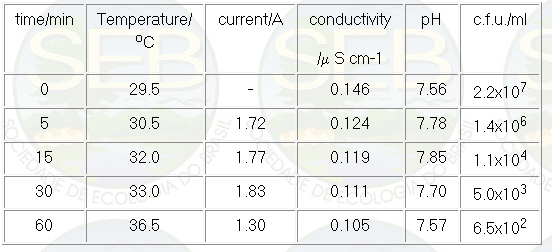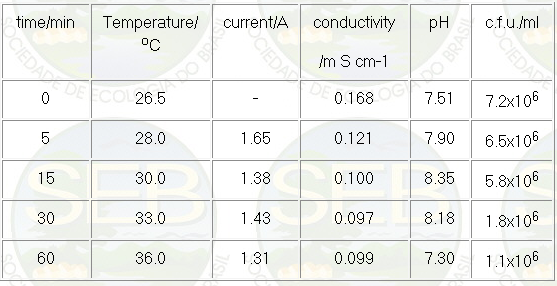Voltar
ELECTROLYSIS OF CELL SUSPENSIONS
OF Bacillus subtilis (ATCC-9372) AND OF Saccharomyces cerevisiae
(FLEISCHMANN ROYALÒ ) USING CAST-IRON ELECTRODES
Orlando J. Bratfich(1), Roberto N. Domingos(2),
Dejanira F. de Angelis(1) and Ederio D. Bidoia(1) *
(1) Departamento de Bioquímica e
Microbiologia, I.B. - UNESP, 13506-900 - Rio Claro - SP,
Brazil; (2) Departamento de Física, IGCE - UNESP,
13500-900 Rio Claro - SP, Brazil
* Ederio D. Bidoia - Departamento de Bioquímica
e Microbiologia, I.B. - UNESP - Av. 24-A, 1515 - 13506-900
- Rio Claro - SP, Brazil - Tel: +55 (19) 526-4135 - Fax:
+55 (19) 534-0009
--------------------------------------------------------------------------------
ABSTRACT
Bacillus subtilis (ATCC-9372) and Saccharomyces
cerevisiae (Fleischmann RoyalÒ ) cell suspensions
were electrolyzed and the viable cell concentration was
dependent to the electrolysis time. Bacteria showed less
resistance to death than the yeast due to the differences
in cell wall composition. The electrolysis is a suitable
decontamination process to favour yeasts in relation to
bacteria.
Key words: Bacillus subtilis, cast-iron
electrode, decontamination process, electrolysis, Saccharomyces
cerevisiae
--------------------------------------------------------------------------------
Electrooxidation has been shown as a viable
alternative to biological treatments of wastewater (1, 2).
Electrolysis can reduce the number of viable cells without
the need of adding any chemical substances (3). Microorganism
growth rate can be controlled by electrolysis because one
species can have its growth rate partially or totally unchanged
while other species can be strongly affected (4).
In this work, two kinds of microorganism
suspensions, one containing Saccharomyces cerevisiae (Fleischmann
RoyalÒ , a yeast used in ethanol production processes
from sugar cane, and the other containing Bacillus subtilis
(ATCC-9372), an endospore-forming gram-positive bacterium
which is resistant to adverse conditions, were electrolyzed
with the objective of evaluating the decrease of colony-forming
units per ml (c.f.u./ml) with the electrolysis time The
electrolyses were carried out using an electrode assembly
containing 14 plates of cast iron (2 mm thickness, total
geometric area of 1109 m2) spaced 5 mm apart. A volume of
1.8 l of microorganism suspension was electrolyzed in every
trial under magnetic stirring. A DC power source (Fok Gyem
- model TR-9158/A) was used to apply a constant potential
of 15.0 V; at this voltage the current is greater than 1
A, which leads to a c.f.u./ml reduction of more than 90%
in the maximum time of 60 min. After different electrolysis
times, the electrolyte was sampled for cell counting and
to determine its conductivity, temperature and pH.
The growth conditions enumeration method
and the culture media utilized for B. subtilis and S. cerevisiae
were the following:
The suspensions (1.8 l) were prepared by
the addition of centrifuged cell pellets (4000 rpm for 10
min) in sterilized tap water. The initial viability was
2.2 x 107 cell/ml of bacteria or 7.2 x 106 cell/ml of the
yeasts (Table 1 and 2). Sterilized tap water was used as
a reference substrate for the pH and conductivity measurements.
Table 1 - Data for the electrolysis of
a B. subtilis (ATCC-9372) suspension at 15.0 V.

Table 2 - Data for the electrolysis of a S. cerevisiae
(Fleischmann RoyalÒ ) suspension at 15.0 V.

. The B. subtilis (ATCC-9372) cultures
were grown in nutrient broth (3 g of beef extract, 5 g of
peptone in 1 1 of water) at 150 oscillation/min during 24
h and pH = 7.0. The bacillus cells were quantified as c.f.u./ml
by PCA (plate count agar) using the technique of pour plate
after incubation for 72 h at 360 C to determine the viable
total-cell counting.
· Pure yeast cultures of S. cerevisiae
(Fleischmann RoyalÒ ), a non-flocculating strain,
were grown in a YEPD broth (10 g of yeast extract, 20 g
of peptone, 20 g of dextrose in 1 1 of water) at 150 oscillation/min
during 24 h and pH = 6.5. The yeast cell counting number
was determined as c.f.u./ml in YEPD agar (YEPD broth plus
18 g of agar) using the technique of pour plate for 72 h
at 300 C.
As shown in Table 1, about 94% of the B.
subtilis (ATCC-9372) cells could not be recovered in the
plate count after 5 min of electrolysis. On the other hand,
the yeast (S. cerevisiae - Fleischmann RoyalÒ ) showed
a higher resistance to electrolysis, since only 10% of the
individuals died after 5 min of electrolysis (Table 2).
Probably, this difference in resistance to death from electrolysis
is mainly due to the different composition of the cell walls
of the two microorganisms. Considering that the conductivity
and pH have not changed significantly (great changes in
conductivity and pH could diminish the cell viability of
the suspensions), the main cause of the decrease in the
cell viability was the electrolysis time. Furthermore, electrolysis
causes the yeast to flocculate, despite it being a non-flocculating
strain (the flocs consisted of dead cells with some live
cells trapped inside, which was observed using erythrosin
dye); this should be caused by changes in the superficial
charges around the yeast cell wall during the electrooxidation.
The B. subtilis cells, on the other hand, did not flocculate
and the electrolysis was efficient to kill most of the cells.
In conclusion, these results indicate that electrolysis
might be well suited as a decontamination process to favour
yeasts (fungi) in relation to bacteria.
--------------------------------------------------------------------------------
RESUMO
Eletrólises de Suspensões
de Bacillus subtilis (ATCC-9372) e de Saccharomyces cerevisiae
(Fleischmann RoyalÒ ) Utilizando Eletrodos de Ferro
Fundido. Suspensões celulares de Bacillus subtilis
e Saccharomyces cerevisiae foram eletrolisadas e observou-se
que a concentração de células viáveis
era dependente do tempo de eletrólise. B. subtilis
mostrou-se menos viável que S. cerevisiae após
tratamento eletrolítico provavelmente devido a diferenças
na composição da parede celular. A eletrólise
atua como um processo de descontaminação de
bactérias em suspensões contendo leveduras.
Palavras-chave: Bacillus subtilis, eletrodo de ferro, eletrólises,
processo de descontaminação, Saccharomyces
cerevisiae.
--------------------------------------------------------------------------------
REFERENCES
Genders, J. D.; Weinberg, N. Electrochemistry
for cleaner environment. Electrosynthesis Co, East Amherst,
1992.
Patermarakis, G.; Fountoukidis, E. Disinfection of water
by electrochemical treatment. Water Research, 24: 1491-1496,
1990.
Tokuda, H.; Nakanishi, K. Application of
direct current to protect bioreactor against contamination.
Bioscience Biotechnology Biochemistry, 59: 753-755, 1995.
Karba, R.; Gubina, M.; Vodovnik, L. Effects of direct electric
current on the growth of microbes and their susceptibility
to antibiotics. Bioelectrochemistry and Bioenergetics, 30:
173-180, 1993.

